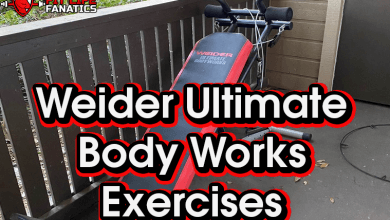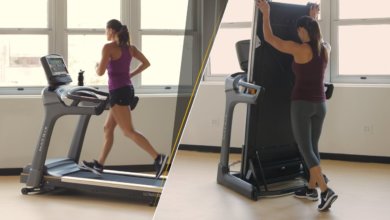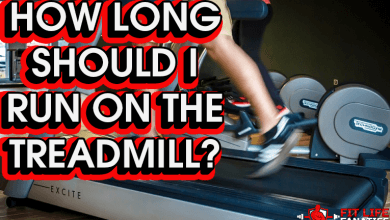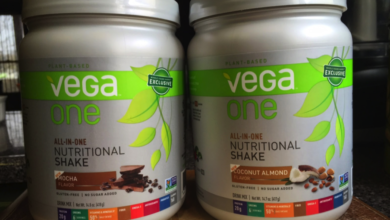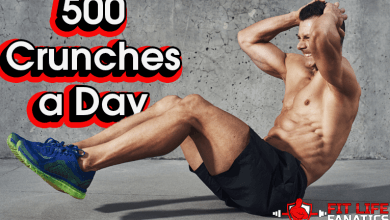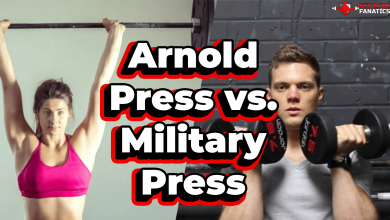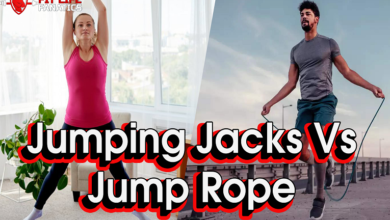Best Short Barbells That I Would Personally Buy for My Home Gym 2024
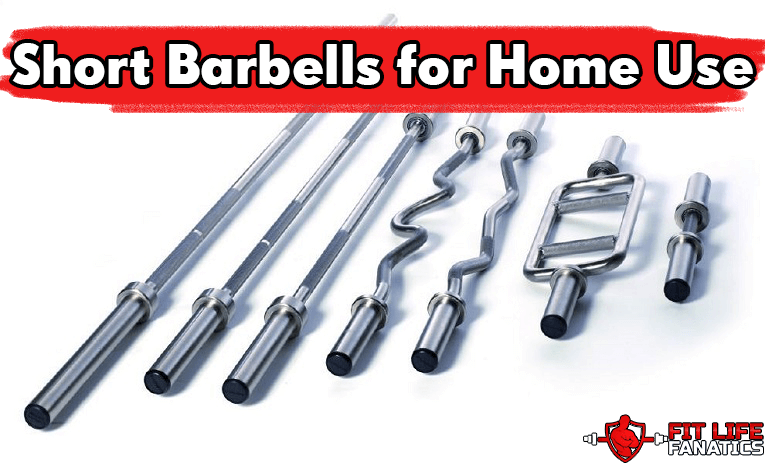
Not all of us live in a mansion. But most of us still want mansion-esque home gyms. Yeah. We can sleep under the bench if need be. But there’s no way we are going to cut short on equipment, are we?
Unfortunately, barbell sizes, and squat racks seem to disagree with our world views. They continue to hog on the same amount of precious real estate, irrespective of whether you live in a tiny apartment or Wayne manor.
I’ve been in a similar situation where I almost had to choose between installing a full-sized squat rack with Olympic barbells, or swap them for short barbells for better optimization of the available space.
I chose the latter. Short barbells are godsend if you have limited room, with some like the American T-grip Shorty bar being a mere 4ft long.
Most manufacturers make them these days because of obvious reasons. There’s a lot of people like us who want to have a barbell for using at home. But are skeptical because of space constraints.
When faced with an identical conundrum, I spent the next three months immersing myself into the world of short barbells. I spoke to hundreds of users on messaging boards.
I went out to big box stores and spoke to the sales guys. I even spoke to coaches and trainers to get an insider perspective on these.
This is what I discovered.
Before getting into the details though, here's a rundown of the major specs.
Barbell | Length | Diameter | Weight | Max. Load |
|---|---|---|---|---|
4.9ft | 28.5mm | 25lb | 90,120, or 245lb | |
5ft | 28 mm | 25lb | 500lb | |
5.9ft | 28mm | 33lb | 2,200lb | |
6.1ft | 28mm | 33lb | 800lb | |
5ft | 25.4mm | 12lb | 250lb | |
5.5ft | 25mm | 22lb | 180-200lb | |
6ft | 28.5mm | 15lb | 125lb | |
5ft | 28mm | 26.5lb | 350lb | |
5ft | 32mm | 26.2lb | 440lb | |
4ft | 28mm | 10lb | 300lb |
Quick Summary;
Which Bar Matches Your Budget?
Above is a run-through of the main specs that you might want to check out real quick, but how about the price; how do different bars herein fare against the rest of the lot? Well, let’s find out...
First things first, do note that some of these bars might seem insanely priced when compared to their cheaper counterparts.
I know some of you don’t mind parting with more for the high-end options, like the Fringe Sport Shorty Olympic bar, which you can find on Amazon by clicking here. But then, some would do with a simple, affordable one; say the Sunny Health & Fitness 60-inch bar, for example, which is also available on Amazon for dirt-cheap.
So I included options from both ends of the spectrum, and everything in between.
If you are like me and just want the best bang for the buck option, then grab the CAP Barbell Olympic bar off Amazon at a very affordable price tag.
And while still at it, you don’t have to spend a fortune on a highly priced bar just for the hype on weight capacity.
Yes, the Fringe Sporty can handle a whopping 2,200 pounds, and the Get rx Shorty too tips the scale at 800lb capacity….But when it comes to it, do you really need to lift all that weight?
Turns out, you might need these bars for just 300 pounds at most.
Now, you could get the same weight capacity with the American Barbell Shorty, which you can find on Amazon for a fraction of the cost.
And for beginners who don’t have the strength and experience to lift tons of weight, even the 129lb that the CAP Barbell Aluma-Lite can easily support might be more than you need.
What Classifies a Barbell as A Short Barbell? What Are the General Requirements?
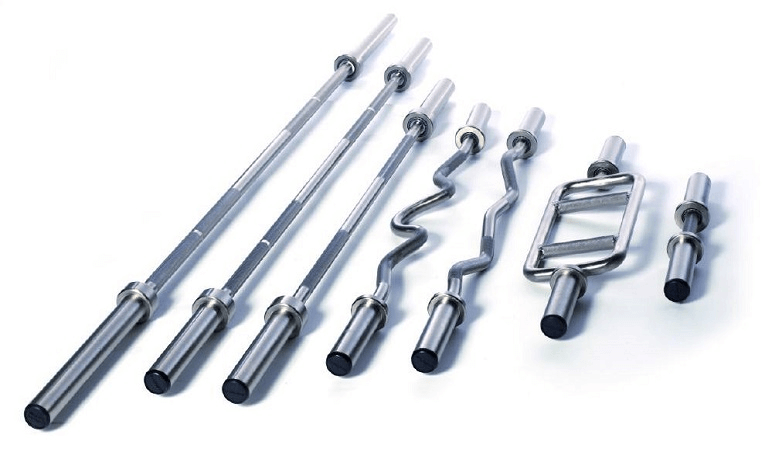
First things first, what exactly does a short barbell mean? Well, there’s no universal definition for a short barbell. It’s a catchall phrase used to describe barbells that are shorter than standard Olympic bars.
The size of a standard Olympic bar is 220cm (7’2) with about 52” of shaft length between collars. Anything smaller than this can technically qualify as a short barbell.
There are many different sizes available these days. But here are some of the common ones that you might find.
- Women’s Olympic Barbells – 200.6 cm – 6’7
- 6-feet barbells – 182.8 cm
- 5-feet barbells – 152.4 cm
One of the questions that I had initially was, what part of the barbell is shortened to achieve the compact design?
That differs from one brand to the other. Some brands reduce the shaft length, others just make the sleeves shorter. There are some really small barbells that have both, shorter shafts and sleeves.
The length is not the only thing that keeps reducing though.
The shaft and sleeve diameters change as well. Olympic barbells have shafts that are 28 millimeters or about 1.1” in diameter. If you are looking to perform Olympic lifts, this is the bare minimum shaft diameter to aim for.
As you would imagine, the shorter the bar, the more difficult it gets to find a rack that can accommodate it.
So the first question that you need to ask yourself is whether you need a rack or not?
That depends entirely on the kind of workouts you perform. Most people would like to go with a rack while performing any kind of barbell workout. Racks allow you to lift a few extra pounds without the need for a spotter. They are safe, stable and necessary in my opinion.
But if you do not have room for a rack, or have just started off with barbell training, then you can very well pick a much shorter barbell.
During the course of my research, I analyzed both categories. Barbells that can be racked for squats, overhead presses & bench presses, as well as shorter ones that can be used with a compact, space-saving rack.
The first category requires a shaft that’s 50” at least.
Benefits of Short Barbells
Short Barbells, also called ‘Shortie’ in bro fitness lingo comes its fair share of advantages, particularly for home gym users.
The pandemic threatens to extend its hideous tentacles into 2021 as well. A shorty might be a great buy if you are looking to stay in shape at home. Here are some of the other advantages.
Related Reading; Cambered Bar Curls, What Are They And How To Do Them?
#1 – it’s Great for Beginners
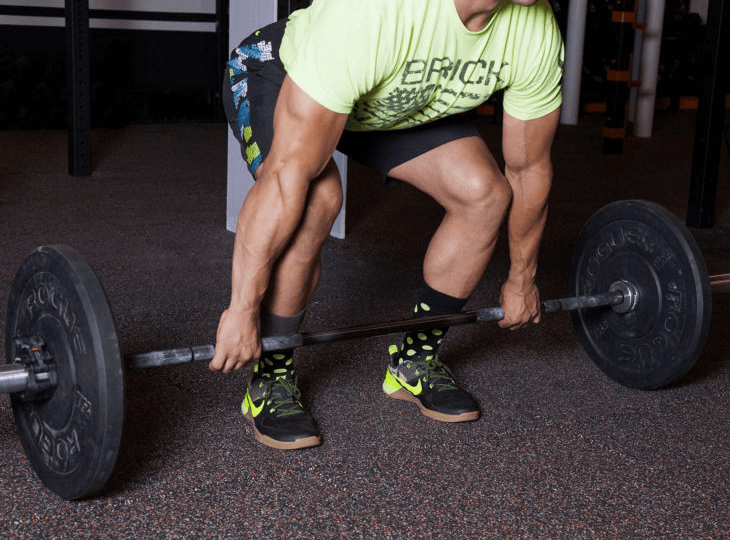
Barbell training is the fundamental tool for both strength and hypertrophy. However, it’s not the ideal introduction to weights for someone who’s new to this. Most experts advice beginners to go for dumbbells instead and for good reason too.
Barbells require a fair bit of strength, balance and stability. Imagine yourself with a loaded barbell performing an overhead press or a squat. If you have never done it before, you will find it challenging to maintain a neutral back as you squat down to the bottom.
Ditto when you rise back to the top position. Your stabilizer muscles kick in, your core must be braced, your back must not bend. It’s not easy with a barbell.
Shorter barbells are less intimidating. They are a step-up from dumbbells. A lot of new fitness buffs feel that dumbbells make them seem like rookies, they would prefer to do exercises like the seated tricep press.
This makes that go away. You are still handling a barbell. You can perform almost all the moves that you’d perform with a full-sized Olympic barbell.
The only difference is that this one is lighter and easier to handle.
#2 – Great for Women
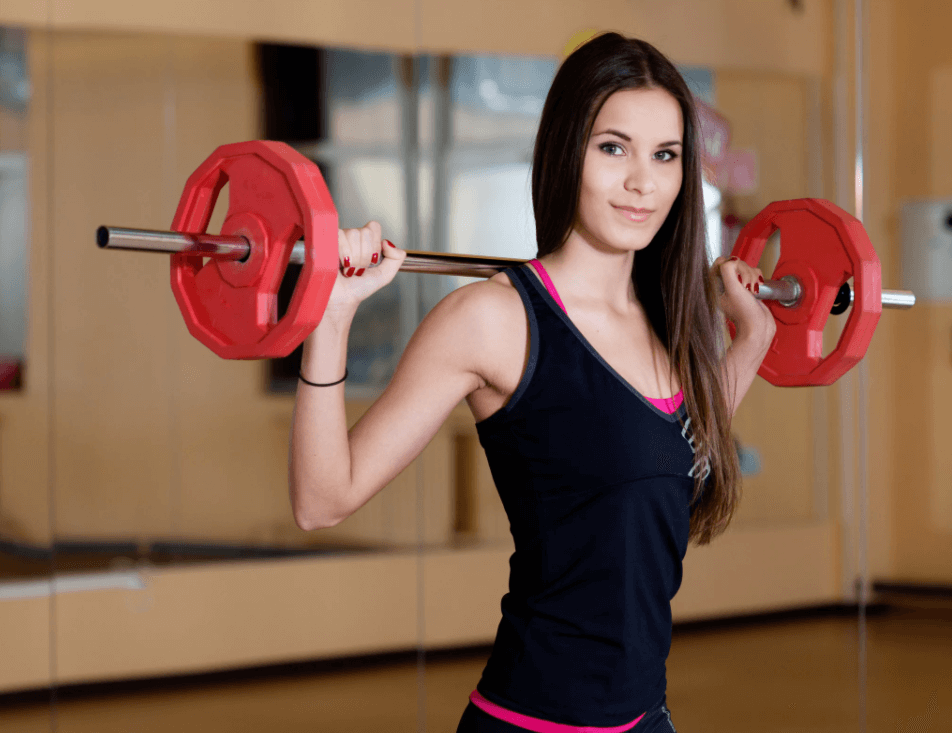
With all due to respect to the ladies who can lift a ton, shorter barbells are more female-friendly. That’s why the female Olympic bar is 201 cm with a 2.5 cm shaft diameter. But even that size can be difficult for a much shorter and lighter female athlete.
Shorter barbells might be easier to rack on the shoulders. The lighter weight compared to the average bench press bar weight or the average trap bar weight allows female athletes to gradually progress into heavier weights rather than starting off with a barbell that’s 33 lb. (weight of the female Olympic barbell).
That’s true even for men by the way. A lot of Asian athletes regularly use standard barbells which have thinner shafts. There’s nothing wrong with it though. Their average height is lesser than Caucasians. They have smaller palms. They just find it easier to grip a thinner bar.
The only possible downside to this that I can think of, is the difficulty that they might face in adapting to standard-sized bars, if and when they progress into more serious weight lifting.
Most fitness clubs in the US will only have standard-sized bars and if you go one fine day from a thinner, shorter bar to a heavier, longer one, you might find it difficult to adapt to.
But if you are looking to stay at home for your workouts for the near future, there’s no doubt about this.
A shorter barbell will be a better option.
#3 - Great for Certain Exercises
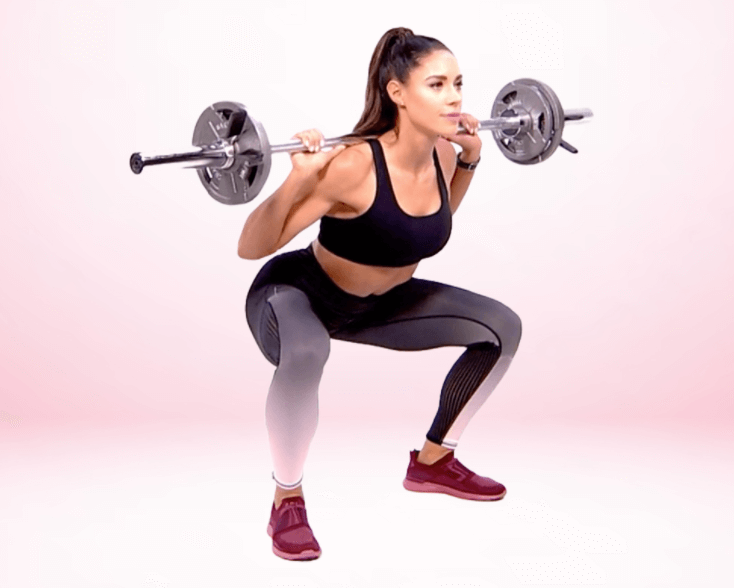
Shorter barbells by design are better suited for certain exercises. These are normally the ones that do not require a squat rack , shoulder press machine or a cage.
In other words, anything where you are looking to lift the weight off the ground. For instance, bicep exercises, shoulder exercises, high pull rows, upright rows, pendlay rows... Triceps exercises, farmers walks, one-hand thrusts and so on.
Longer bars tend to have more whip to allow for power moves. Shorter bars on the other hand are denser and will not bend as much.
#4 – Great for Basement Gyms
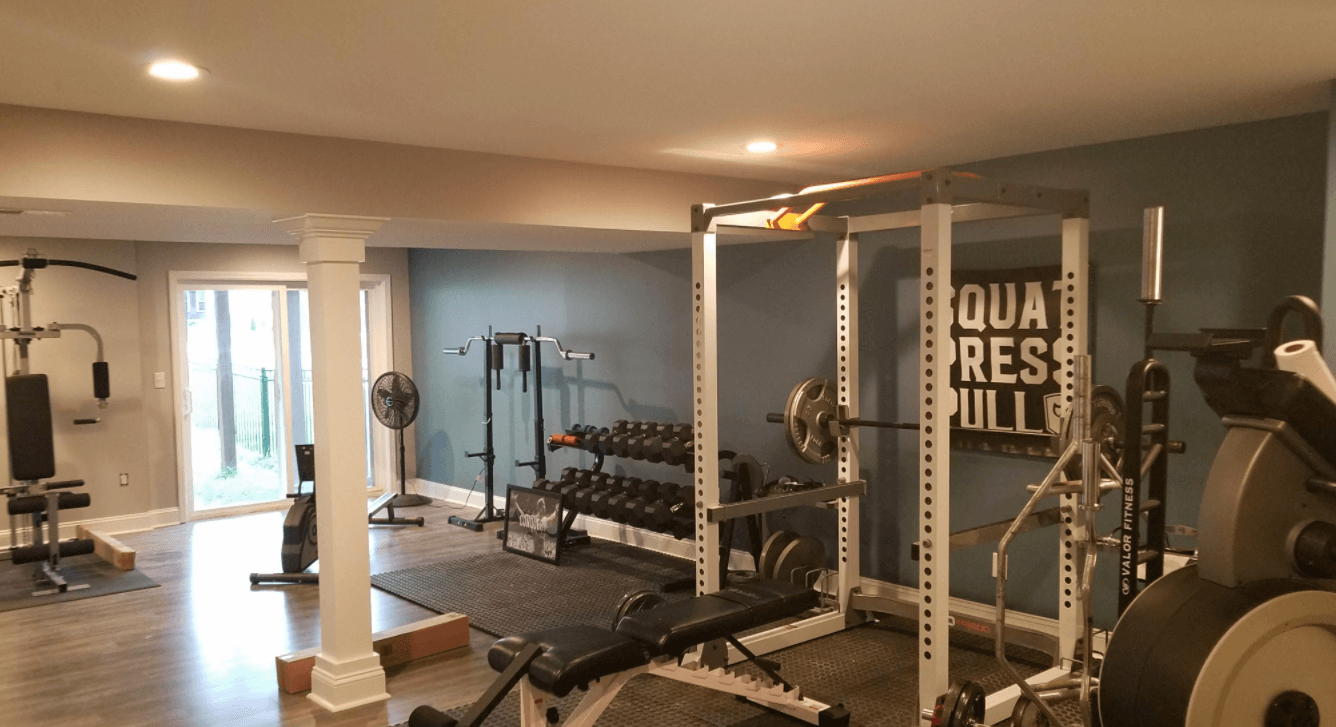
How many of you lift in a low-height basement? Chances are that the ceiling is 8’ at best. A shorter barbell will allow you to lift overhead without compromising on the range of motion.
There are some workarounds involved.
You will most likely need to swap your iron plates with steel ones and throw in some urethane dumbbell bumpers on them. But you don’t have to worry about the bar or the plates hitting the ceiling.
Why you can even perform a clean and jerk in a low-height basement, with a shorty bar. On the other hand, if you have a standard Olympic bar, there’s no way you are getting away with a clean and jerk without hitting the ceiling, or at least scraping it.
An inch here or there and bang!
Also, shorter barbells need less room for clearance as you move around. If you are moving around in a really cramped space, this will allow you to turn or take a few steps without bothering about knocking your training partner over.
If I don't have a lot of space and looking for space saving home gym equipment, I would definitely include a short barbell. The pros are too much to ignore.
Best Short Barbells on The Market
All said and done, let’s take a quick look at the best shorty barbells in the market currently.
#1 – Rogue C-60B Bar and Bumper Set
Best Bang for Buck Option
Best Features
- Made in the USA
- 190K Tensile steel
- 59” in length
- Perfect for compact spaces
- 28.5” in diameter
- Dual knurl
- Comes with bumpers in different weight capacities

Rogue C-60B Bar and Bumper Set Review
This is a 5-feet compact bar from Rogue that’s perfect for cramped spaces, such as basement gyms and tiny apartments. It’s a complete set of a bar and dumbbell bumpers, which means that you can store a lot more weight in a much smaller space.
Tech Specs
- Bar length - 59.198"
- Shaft length - 44.18"
- Shaft Diameter - 28.5mm
- Sleeve length - 7.5" for bumpers, 6.875” for plates
- Weight – 25 lb. unloaded
- Rackable - No
The C-60B is a compact short barbell crafted from 190K tensile strength steel. It features a matte black, Cerakote finish on the shaft, while the sleeves are chrome coated. The length is shorter but the diameter is not thinner. So, you are not going to miss the grip that you get in an Olympic barbell. Also, it features dual knurl for a firm grip while lifting heavy.
You can choose from three bumper packages depending on your fitness goals. The basic set is 90 lb. Then there’s a 120 lb. one and finally, there’s a full set which totals to 245 lb. By the way, the sleeves are compatible with standard 1.9” plates as well. The only possible quibble that someone can have with this is that it’s not rack compatible because of the smaller shaft length.
#2 – Cap Barbell 5-Foot Olympic Bar
Best Cheap Option
Best Features
- Weighs just 25 pounds
- 63,800 PSI tensile strength for ultimate performance
- One of the shortes options at 5-feet long
- 28mm in diameter
- 9.75-inches loadable sleeve
- Knurled grip type for a firm, solid grip

Cap Barbell 5-Foot Olympic Bar Review
This Cap Barbell Olympic bar is by far one of the best picks those of you who are on a shoestring budget can get their hands on. But before you brush it off as just another El-Cheapo on the market, here this!
Despite going for slightly over 50 bucks, this bar still packs quite a punch, especially considering that it’s made of high PSI alloy steel. This gives it enough strength to take on up to 500 pounds without any give or break.
Tech Specs
- Bar length – 1525 mm
- Shaft length – 37 inches
- Sleeve length – 9.75 inches
- Sleeve diameter – 2 inches
- Weight – 25 pounds
Cap Barbell also did a great job at ensuring this bar fits nicely in our tight apartments where we hardly have the luxury of space. At only 5-feet long, you can use this bar in that cramped room or inside a small gym; no sacrifice, no compromise.
Its knurled grip is something definitely worth a mention. You will love it when it’s finally time to put this bar to the test – yes, you can pull off a variety of lifts with this one. By this I mean anything from bench presses to squats, and even full body workouts.
A rotating sleeve design is also on hand to ease the pressure on your wrists and the forearms, which makes this bar perfect for beginners and pro lifters alike. And of course, the black powder coat used for the finish not only makes it look cool, it also enhances its durability, too!
#3 – Fringe Sport Shorty Barbell
Great for Olympic-style lifts in tight spaces
Best Features
- 2200 lb. weight limit
- 216,200 PSI Tensile strength steel
- 6-feet length
- 28 mm in diameter
- Full length shaft
- Perfectly suited for compact spaces
- Dual Knurl
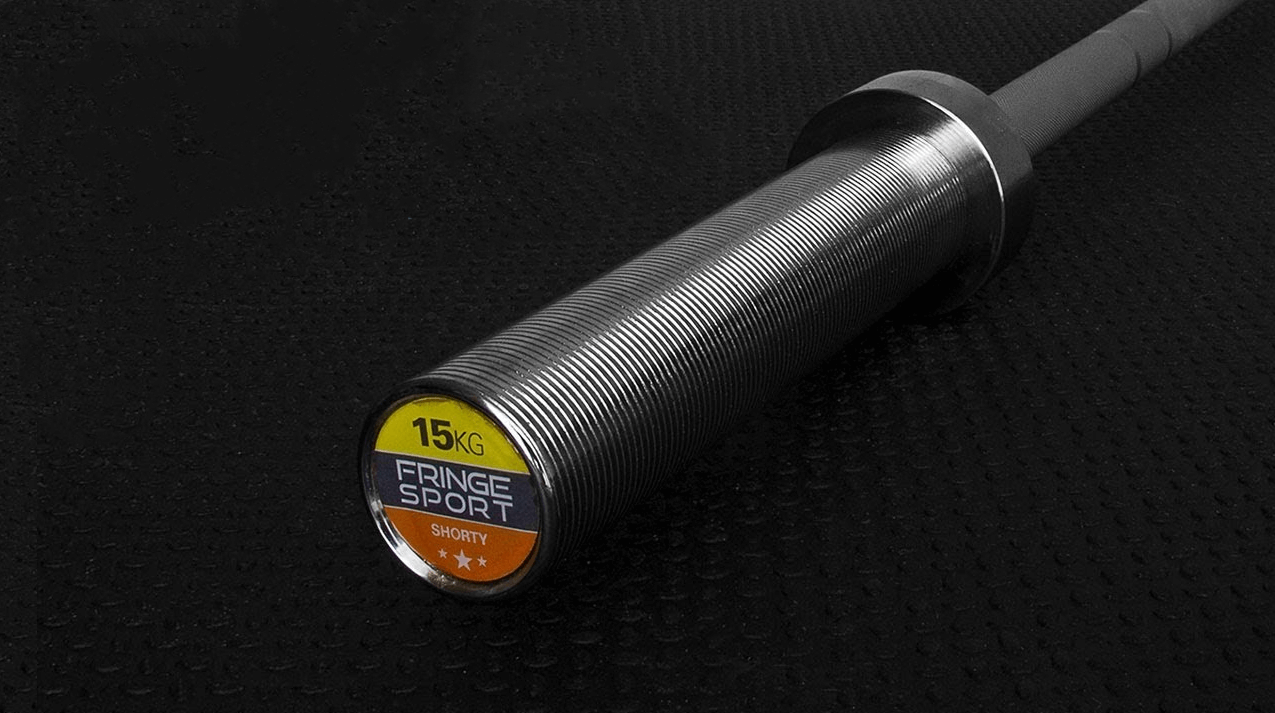
Fringe Sport Shorty Barbell Review
The Shorty from Fringe Sport ticks the only box that the Rogue C-60B doesn’t. It’s rackablein squat racks as well as benches.
It’s a 6-feet barbell though. Well, a feather less than six feet considering that the total length is 71 5/8". But like I mentioned earlier, Fringe sport has smartly reduced the sleeve length keeping the shaft intact at 52”. This makes the Shorty a great fit for a variety of Olympic styled lifts in compact spaces.
Tech Specs
- Bar length –71 5/8”
- Shaft length –52”
- Shaft Diameter –28mm
- Sleeve length –8 7/6”
- Weight – 33 lb. unloaded
- Rackable – Yes
The Shorty is crafted from 216,200 PSI high-tensile steel and features a matte chrome finish. It is rated for a whopping 2,200-pounds. Although at that sleeve length, the max that you’ll be able to load on this is 400 lb. But you can be rest assured that the bar’s not a flimsy one that’s going to die on you.
The big draw is the full-length shaft at 28mm diameter. It allows even tall athletes to perform power moves such as the full-width snatch grip in a low-height basement. It’s a fairly stiff (low whip) shaft by the way. You’d want to keep that in mind when you perform snatches and the likes.
#4 – Get RX’d Shorty Bar
Great Value for Price
Best Features
- 74” barbell with 28mm diameter
- 52” full sized shaft
- 190K PSI tensile steel construction
- Hard chrome coated, Rust resistant
- Prominent dual knurling
- Oversized sleeves for additional plates
- 800 lb. max weight capacity
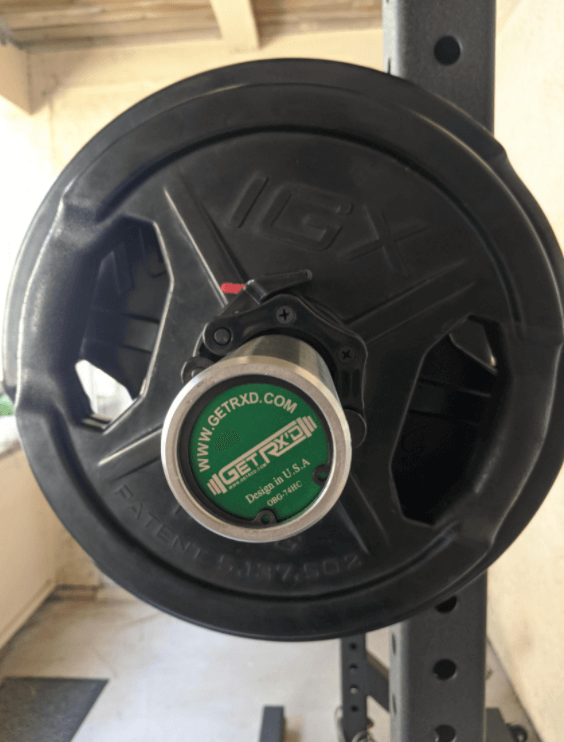
The Get RX’d Shorty Bar is a wee bit longer than the Fringe Sport one. It’s 74” in total, which means that you get a full length shaft with it. Also, the few extra inches translate into additional sleeve space, which can be useful if you are loading thinner plates.
It’s rated for 800 lb. The max that you can go with bumpers though is 300 lb. That’s more than what most people lift at home.
Tech Specs
- Bar length – 74”
- Shaft length – 52”
- Shaft Diameter – 28mm
- Sleeve length – 9.84"
- Weight – 33 lb. unloaded
- Rackable – Yes
It features 190K PSI steel construction with a hard chrome coating. It’s rust resistant, has prominent knurling that extends all the way to the collar and is fairly stiff, with very little whip to it. Makes it perfect for most types of lifts. The shaft is 28mm and full-sized. Any Olympic lifters with limited room at home will love this.
At 33 lb. unloaded, it’s not as heavy as a full-sized Olympic bar. But it’s not as light as some of the flimsy thinner models that are being sold online either. This is a very versatile short barbell. Great pricing too.
#5 – Sunny Health & Fitness Chrome Barbell Bar
Most Affordable Option
Best Features
- Lightweight option at only 12-lb weight
- 60-inch length
- Knurled grip type for slip-free hold
- Chrome finish gives it a cool look
- Star-locked collars for safety

This Sunny Health & Fitness chrome bar isn’t something an avid lifter would be very thrilled about. That’s right, to be honest, it’s pretty basic, but that doesn’t seem to be an issue for most beginners who just want a bar to try out a few lifting tricks and figure out if it’s something up their alley or not.
Also, for the folks out there who are really tight on budget, this one will save the day for y’all. With that out of the way, let’s take a closer look at what this bar has to offer.
Despite the simple design, and the cheap price, I still loved the alloy steel build, which screams performance and durability. To dive deeper into the performance, this bar can only go as far as supporting 250 pounds. I know, it might sound ridiculous for some, but for a total beginner, that’s more than enough for a start.
Tech Specs
- Bar length – 60 inches
- Diameter – 1 inch
- Weight – 12 pounds
- Material – Solid chrome steel
- Weight capacity – 250 pounds
The grips are knurled too, for a firm and secure grip when lifting, and Sunny Health doesn’t leave it at that; the bar also comes with star-locked collars for securing the weights in place. You will need it if you are just starting out on your strength building and your balance for the weights is slightly wanting.
I also have to give it up for the other cool bits like the chrome finish, which makes the bar a snap to clean. Not forgetting that this is one of the most versatile bars out there that you can use for a wide array of exercises; from bench presses to rows, deadlifts, cleans…you name it!
Seriously, this might not be the best bar on this list or out there, and rightfully so as it isn’t among the insanely priced ones. All I can say is for the price, it's quite a deal.
#6 - Rogue 10kg Junior Bar
Great Option for Beginner Lifters and Teens
Best Features
- 5 ½’ bar with a full-sized shaft for racking
- Weighs just 22 lb. unloaded
- 6.625” sleeves
- Max weight rating of about 180-200 lb.
- Excellent option for building form or for lightweight lifting
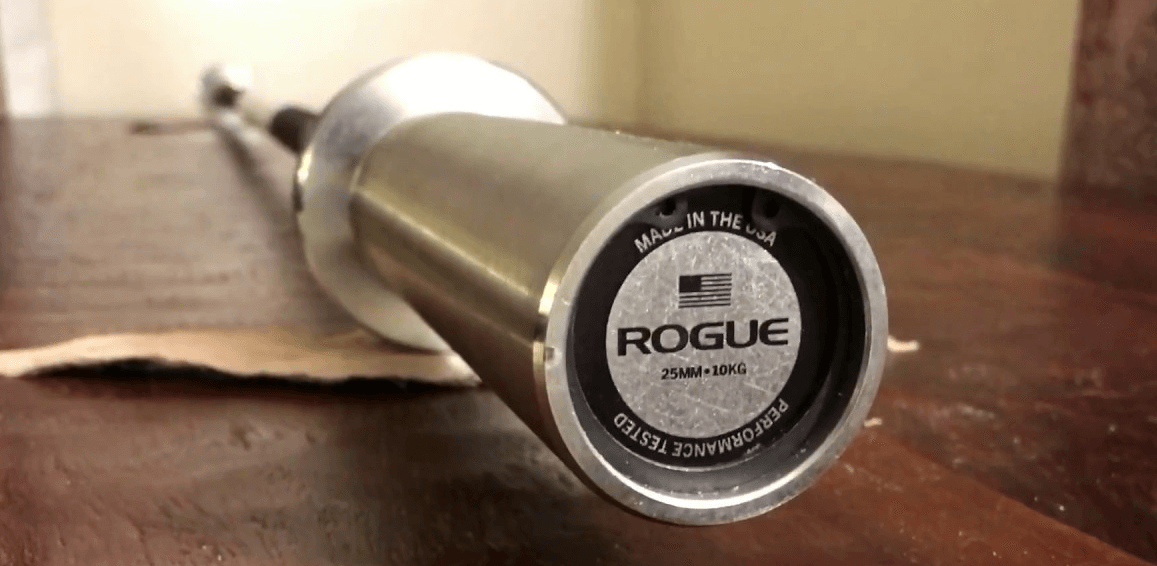
Don’t let the ‘Junior’ in the name sway you into believing that this is a bar solely made for kids. I mean, sure. Teens will find it easier to handle. But this is an excellent lightweight barbell even for beginners. It’s 25mm in diameter.
That’s only marginally thinner than an Olympic bar. Moreover, it features a full length shaft that’s 52”. So, if you are looking to build your form for Olympic lifts, such as the clean and jerk, this is a great option.
Tech Specs
- Bar length – 66.80”
- Shaft length – 52”
- Shaft Diameter – 25mm
- Sleeve length – 6.625"
- Weight – 22 lb. unloaded
- Rackable – Yes
The Rogue Junior Bar is made of 190K tensile steel and has a black zinc coating on the shaft. The sleeves are chrome plated and about 6.625” in length. It suffices to load about 180-200 lb. To add to this, the bar weighs just 22 lb. unloaded.
That’s about the perfect weight for perfecting form. If you are a short guy or girl and looking for a sturdy, lightweight bar, look no further.
#7 - Cap Aluma-Lite Olympic Training Bar
Best Lightweight Option for Form Training
Best Features
- 15 lb. 6-feet barbell
- 52” shaft for racking on a bench or in a cage
- 40000 PSI tensile strength aluminum
- Max weight rating of 125 lb.
- 28.5mm diameter
- Extra-long sleeves that’s compatible with Olympic plates
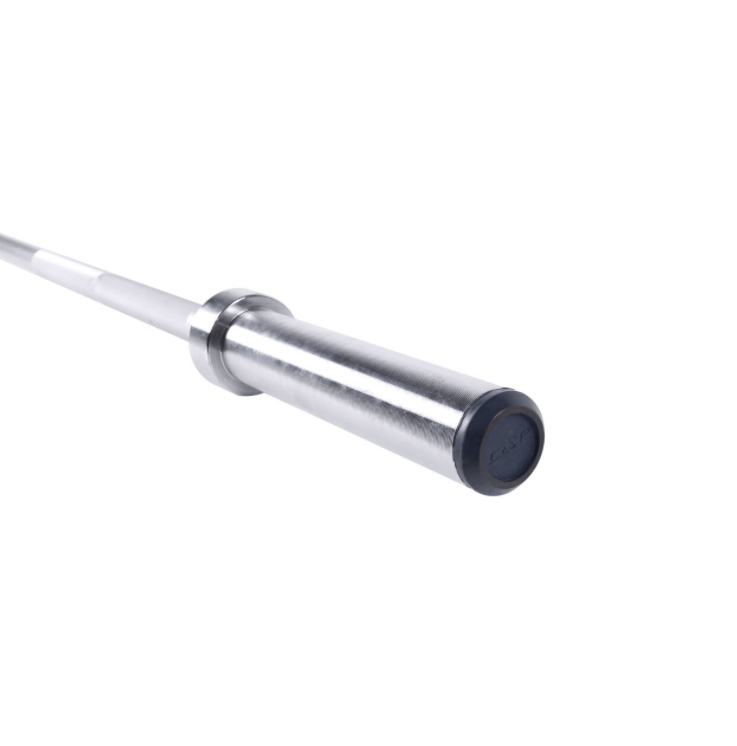
The Cap Aluma-Lite Olympic Training Bar is a very light full-sized bar typically used for form training for Olympic lifts. I call it a full-sized bar because it features a 52” shaft that can be racked on a bench or in a cage.
The bar is 73”. So it’s just 6-feet. The big draw here is the weight. It’s just 15 lb. If you find conventional bars too heavy for form training, here’s your ticket.
Tech Specs
- Bar length – 73”
- Shaft length – 52”
- Shaft Diameter – 28.5mm
- Sleeve length – 9.75"
- Weight – 15 lb. unloaded
- Rackable – Yes
The Aluma Lite is crafted from lightweight aluminum that’s 40,000 PSI tensile strength. Make no mistake, this is a very sturdy bar. It’s rated for about 125 lb. which is more than sufficient if you are looking to develop strength and form. This is not a barbell to lift a ton of weight though.
Apart from the lightweight construction, there’s not much difference between this and a standard Olympic barbell mind you. It’s 28.5 mm in diameter, it features rotating sleeves and there’s ample knurling to give you a firm grip.
#8 – RitFit Olympic Barbell Bar for Men and Women
Best Short, Lightweight Olympic Bar
Best Features
- Perfect surface for knurling grips
- A maximum weight rating of 350 pounds
- High-quality alloy steel with an oxide or chrome finish for exceptional durability
- 36.5” shaft with a diameter of 28mm
- Weighs 26.5 lb.
- Perfect for various strength-training exercises
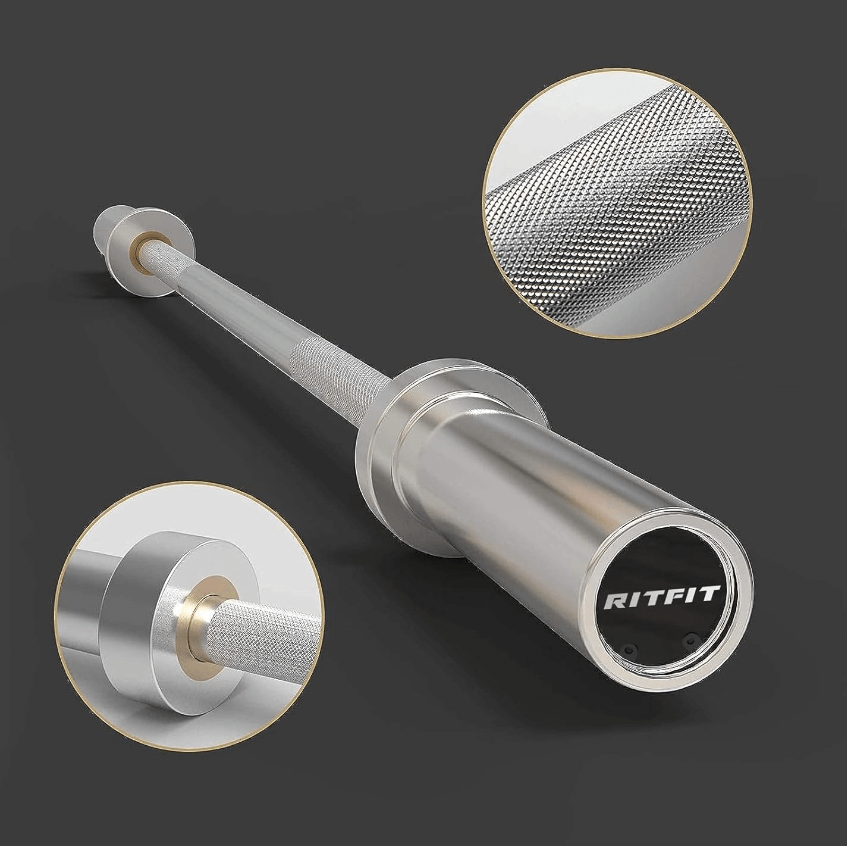
If you’re on the hunt for a sturdy and durable weightlifting bar for deadlifts, bench presses, landmines, or squats, this Olympic barbell bar from RitFit checks all the boxes.
Tech Specs
- Bar length –59
- Shaft length –36.5”
- Shaft Diameter –28 mm
- Sleeve length –10"
- Weight –26.5 lbs. unloaded
- Not rackable –n0
The RitFit Olympic Barbell Bar, with its durable finish and a rugged build, is endowed with lifetime durability. Its max weight rating is a testament to its resilience. This means you can stack as much weight as you can carry. Additionally, it has a knurling grip and comfortable texture that provides an immersive weightlifting experience.
The bar has an incredible balance that makes it easy for you to blast through your reps seamlessly. A great recommendation for your workouts!
#9 - Torque Fitness O5B Olympic Bar
Best Strong, Durable Commercial-level Option
Best Features
- Compact 5-feet bar
- Extra thick 32mm diameter
- 440 lb. max weight rating
- Prominent knurling
- Also available in 6-feet
- Compatible with Olympic plates
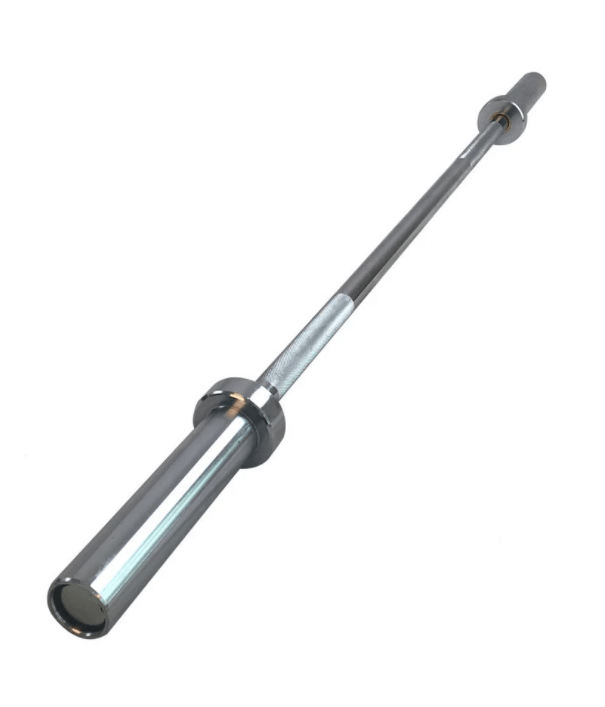
The Torque Fitness 05B Olympic Bar is a commercial-grade shorty barbell that’s used in professional fitness centers. It’s a five-foot bar with a 38.4” shaft. So it cannot be racked. But that’s not really a deal breaker for a lot of home gym users who seek durability and a decent max weight load. This one ticks both those boxes.
Tech Specs
- Bar length – 60.2”
- Shaft length – 38.4”
- Shaft Diameter – 32 mm
- Sleeve length – 7.5"
- Weight – 26.2 lb. unloaded
- Rackable – No
Crafted from high tensile steel with a chrome finish all over, the Torque barbell features free rotating sleeves. Club that with the extra thick 32mm diameter and you have an excellent bar for most training programs. Granted, tall users probably cannot use this for Olympic power lifts. But if you are a short man or woman, this is a great bar to have around home.
It’s compact, it’s rated for 440 lb. & it features prominent knurling. By the way, this is also available in a 6-feet version with a full-sized shaft. If you are looking for a rackable bar, you might want to check that out instead.
#10 – American Barbell T-Grip Shorty Bar
Best Versatile, Multiple-grip Shorty
Best Features
- Really short at just 4ft.
- load capacity of 300lb
- Highly Reviewed.
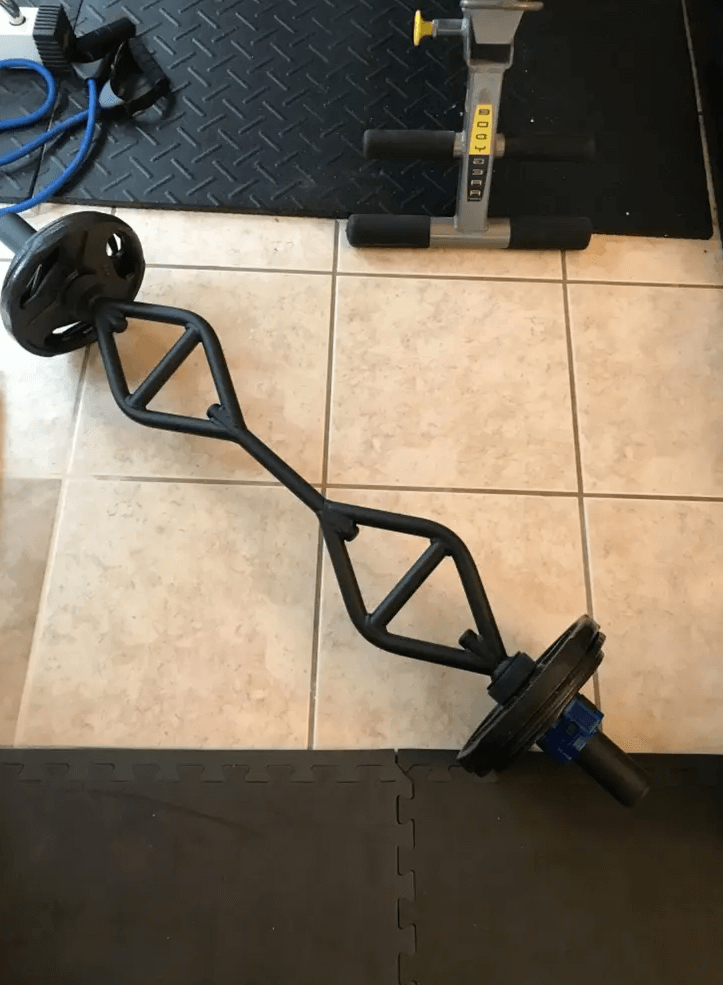
Last but not the least, we have the shortest barbell in this list. This is the American Barbell T-Grip Shorty. It’s a very versatile bar that provides you with multiple grips for targeting different muscle groups.
What we like most about it though, is that it’s just 4-feet. This is as compact as they come. With the multi-grips, it’s like owning three bars for the price of one.
Tech Specs
- Bar length – 48”
- Shaft length – NA (20” between the two T-Grips)
- Shaft Diameter – 28mm
- Weight – 10 lb. unloaded
- Rackable – No
The T-Grip Bar may appear to be a novelty addition to your gym. But the fact is that this is an incredibly versatile bar that allows you to target multiple upper body muscle groups. The most obvious advantage is for Arm Training.
But that’s not the only one. These can be used for back, shoulder and core training too. You can switch between a standard barbell and an EZ-Curl bar. Rated for 300 lb. Sweet!
Barbell Buyer’s Guide: What to Look for When Shopping for a Barbell
It would be fair to assume that most of y’all have never ventured into shortie barbell shopping. So I have created a brief guide that shows you the most important boxes to tick off while deciding on what barbell to select.
#1 – The Quality
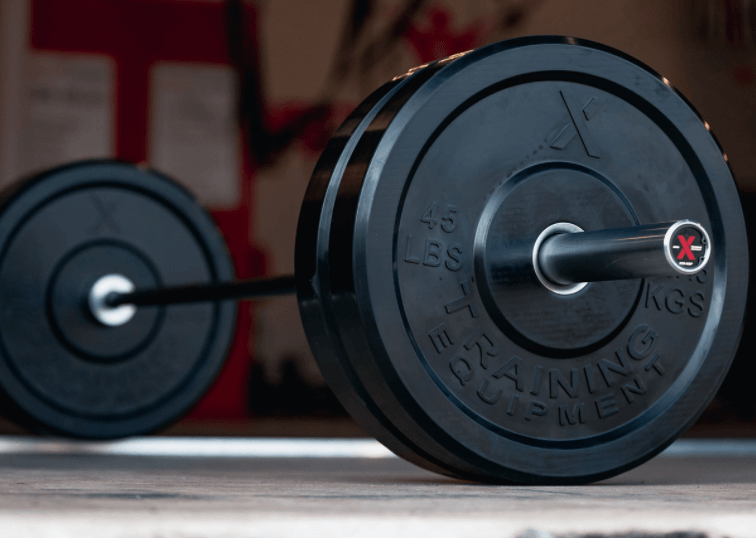
If the friendly, smiling sales guy at the big box sporting store is to be believed, the only real thing that matters while buying a shortie barbell, or any barbell for that matter is the price. But we all know that there’s a lot more to it, isn’t there?
A barbell needs to be built like a rock. That’s a cliché, and a very broad strokes description. But believe it or not, most cheaply made barbells will rust, warp, bend and even break. The last thing you’d want is for that to happen when it’s loaded with 300 lb. and you are under it.
There are three important terms that you need to watch out for while determining quality. That’s tensile strength which determines the load that the barbell can handle before it breaks. There’s yield strength, which is the weight it can handle before bending. Lastly, there’s test, which is the maximum amount of weight that it has been tested with.
Pick a bar depending on the weight you normally lift.
#2 – The Intended Use

What best defines you, as a lifter? Are you a beginner looking to build your lifting form? Are you an intermediate lifter looking to break your previous best lifts? Maybe you want to test your skills in powerlifting. Maybe you are an aspiring Olympic lifter.
Your choice of a barbell will vary depending on your answer to these questions. If you are a beginner, you can pick a lightweight barbell like the Rogue Junior or the Cap Aluma. These will allow you to get a grasp on the form. But you’ll quickly outgrow these and start yearning for a real barbell.
If you are an intermediate lifter, go for something like the Rogue C60. Powerlifters will prefer a stiffer bar, while athletes looking to practice Olympic lifts will want something with a fair bit of flex, and one that has a 28 mm diameter.
Then there’s rackability to consider. Do you intend to rack the bar? Then you need an option with a full-sized shaft, that’s 50-52”.
This will also help you determine the type of knurling you need. Center knurling is preferred by people who rack the bar on the back for squats. Knurling can also extend all the way to the sleeves. But unless you plan to snatch and grip, it’s not really a prerequisite.
#3 – The Available Room

That’s probably the primary reason why you are reading this, aren’t you? Look at the dimensions of the barbell. Do you have enough room to accommodate a 6-feet bar? Account for the space that you will need with the plates loaded to perform an overhead press or a squat.
Some bars are not compatible with Olympic plates and will require smaller plates which will add to the overall cost. Similarly, if you have Olympic plates at home and want to go for a thinner bar, look for one that comes with an adapter sleeve.
#4 – Price

Barbells can cost anywhere from $100 to $2000 and more. Price is rarely an indicator of how good an option it is. So once you consider all the other variables, pick one that’s decently priced.
Top Barbell Brands
Unlike a decade ago where there were only a handful of reputed brands selling barbells, there are like a gazillion different brands out there. (Thank You China).
While I have nothing against Chinese brands, I am a little skeptical about the quality of these bars.
I did check a few of these out myself in a sporting goods store. There seemed to be something off about each one. The finish was flaky. The sleeves were uneven at times.
So, I highly recommend that you buy from trusted and reputed American brands only. More so because your life depends on it. Here are the top barbell brands in the business currently.
#1 – Rogue

No surprises! For a company that started off in just 2007, Rogue has made vast inroads into the fitness industry in very little time.
They are the official suppliers of barbells (the Rogue C-60 bar listed here is just one of many) for the CrossFit Games & the Arnold Strongman Competition among others.
They have one of the most stringent quality control measures in the fitness space.
The barbells are built to outlast the people who will use them, they have even diversified into making equipment like exercise bikes, I reviewed their Rouge Echo bike, an amazing company that makes amazing products. That’s the best way to sum it up.
#2 – Torque

Torque is probably the only brand that I know of, who are not producing identical replicas of the top-selling products.
In all likelihood, this translates into a strong R&D team behind them and a custom design process which I like.
Oh, not to mention that their product quality is top notch. They have some really compact fitness goods. If you are short on space, Torque is a brand that should be on your wish list.
#3 – Fringe Sport

I first discovered Fringe Sport while researching the best bumper plates for my shortie barbell. Turns out that they have some really cool barbells too in their lineup. They are based in Austin, TX. Do check them out.
FAQ
If you still have a niggling doubt or two in your mind about these barbells,then here’s a brief FAQ that aims to answer some common questions that I am asked.
Q. Are Shortie Barbells Less Effective than Their Larger Counterparts?
A. It’s a very legit question with no definitive answer. It’s one of the first ones that popped up in my mind too. I even tried to post this on some fitness and science messaging boards. But I couldn’t dig up any evidence that proves that short barbells are less or more effective than full-sized ones. That said, any lifting is better than no lifting. So, you are better off than what you were without a bar. My advice would be to not get hung up over trivial details. If at all there is any difference, it’s too marginal to make any difference to your body or fitness goals.
Q. Are These Aluminum Barbells as Durable as The Steel Ones?
A. It’s a misconception that aluminum is not as durable or as tensile as steel. However, rather than getting swayed with these details, look at the tensile strength, the yield strength and the test rating. That should give you a fair idea of what to expect.
Conclusion
That’s it fellow barbell lovers. I hope that you found this blog post to be useful in selecting the best short barbell for home use. If you have a personal favorite shortie, I’d love to hear about it and your experiences with it. Do give us a holler and show some love by sharing this with your buddies.
Related Readings:
- Tactical Barbell: My Review and Results
- Should I Squat and Bench on the Same Day?
- 10 Pack Abs – Real or Myth?
- Stamina vs Endurance – Differences, Types, Training Styles, and Exercises For Each
- Hammer Strength Chest Press: Everything You Need To Know
References:
Ben Mayz
Hi there! I'm Ben, main author and chief editor at Fitlifefanatics.com. I have been obsessed with Strength Training and Fitness for 18 years now.
My passion for living a happy fit lifestyle is what made me realize that fitness is what I wanted for my future.
I went on to earn my Masters in Sports Training & Biomechanics.
My passion for Strength training & fitness and my love of helping others is what made me start Fitlifefanatics.
Here, myself, and a team of specialist aim to provide the most accurate, and actionable information possible in hopes to help foster the fitness community forward.
You can learn more about Fitlifefanatics on our About Page
